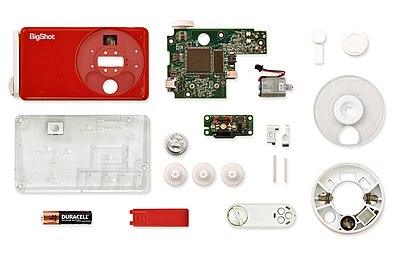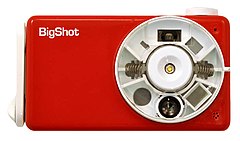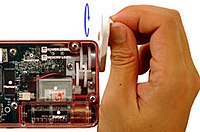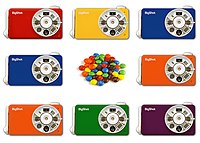Bigshot (digital camera)
Bigshot is a digital camera created by Shree K. Nayar at Columbia University's Computer Vision Laboratory. The camera, currently in the prototype phase, is geared towards global audiences between the ages of 8 and 14 years old. The Bigshot project as a whole combines unique digital camera technology, extensive online and in-person curricula, and a socially-enabled website.[1]
History/Inspiration
In 2004, Ross Kauffman and Zana Briski made the documentary Born into Brothels, an Academy Award-winning portrait of several children living in the red light district of Calcutta.[2][3] The filmmaker gave each child a camera and taught them photography so that they could begin to look at their world with a new set of eyes, unveiling hope and uncovering hidden talents from within themselves. As a result, many of them found the strength to break from their circumstances and begin charting out meaningful lives.
Convinced of the potential of a camera explicitly designed for education, Nayar launched the Bigshot project in 2006.[4] The first set of Bigshot cameras were produced for use in pilot workshops in 2009.
Features

Build-it-Yourself Kit
Bigshot comes as a set of building blocks that students can put together to assemble the camera themselves.[5][1] [6] A step-by-step set of instructions is featured in the Build section of the Bigshot website, and as students build the camera, they get a firsthand look at how the camera (and, by extension, other pieces of machinery and electronics) actually works.[7]
"Swiss Army" Lens
Bigshot features a polyoptic lens wheel, which its creators liken to a Swiss Army Knife™.[8][9] By simply rotating the wheel, the user can choose from a set of different lenses: normal view, panoramic view, and stereo view.[10][11] Photos that are taken in the stereo setting can be viewed with red-cyan 3D glasses to appear three-dimensional.[8][12] The stereo optics is based on a design proposed by D-J. Kang, I. S. Kweon and R. Cippola in 1999.[13] The three rectangles seen in the upper half of the wheel are stencils that convey the fields of view captured by each setting to a person looking through the camera’s viewfinder.[14] The images captured by the wheel are distorted (or coded) and are processed by software to produce the final images, making Bigshot a computational camera.[8][15]
Hand Crank
Although it can be powered with a single AA battery, a human-powered generator is included inside so that it can continue to function if the battery is absent or if it runs out of charge during a photo shoot. The hand crank is coupled to a dynamo through a set of gears, and the resulting power that is generated by the dynamo is stored in a capacitor for use by the camera. About five rotations of the hand crank are enough to produce enough charge for the user to take a photo.
Aesthetics
Bigshot's colors were inspired by those of M&M's™ candies, and the camera's transparent back cover exposes many of its electronic and mechanical components, allowing a student to (for example) show and explain how gears work while rotating the hand crank.[8][5][12]
Preliminary Reception

As of June 2010, a consumer-level version of Bigshot has not yet been made available for purchase, and thus has not been reviewed by camera and electronics professional reviewers.[16] However, prototypes of the camera have been used for community outreach workshops in New York, USA, Bengaluru, India, Vũng Tàu, Vietnam, and Tokyo, Japan with over 200 children, as well as their parents and teachers.[17] Feedback from workshop participants has generally been positive, with several students reporting an increased interest in photography and many teachers praising its ability to promote STEM education.[12] Nayar has indicated that the purpose of the workshops was to explore ways that the camera might address the challenges of children in underserved communities with low access to technology.[18][5][12]
References
- ^ a b "Students Can Build Digital Cameras, Focus On Science Lessons". NY1. 2010-01-21. Retrieved 2010-05-04.
- ^ "Born Into Brothels". Kids With Cameras. Retrieved 2010-05-03.
- ^ "Born Into Brothels". THINKfilm. Retrieved 2010-05-03.
- ^ "Bigshot: Mission". Bigshot. Retrieved 2010-05-04.
- ^ a b c "Bigshot Camera". Change Observer. 2009-12-10. Retrieved 2010-05-04.
- ^ "Big Shot camera kit could help turn your kid on to the dark world of the teardown". Engadget. 2009-11-11. Retrieved 2010-05-04.
- ^ "Bigshot: Build". Bigshot. Retrieved 2010-05-04.
- ^ a b c d "Bigshot: Design". Bigshot. Retrieved 2010-05-04.
- ^ "Bigshot: Polyoptic Wheel: "Swiss Army" Lens". Bigshot. Retrieved 2010-05-04.
- ^ "BigShot Kit Camera, Like Crack for Kids". Wired. 2009-11-13. Retrieved 2010-05-04.
- ^ "Bigshot: Polyoptic Wheel: Introduction". Bigshot. Retrieved 2010-05-04.
- ^ a b c d "BigShot: Snap-together camera introduces kids to tech, and to their world". Christian Science Monitor. 2010-01-06. Retrieved 2010-05-04.
- ^ Lee, D.H., Kweon, I.S., and Cipolla, R., "A Biprism-Stereo Camera System," CVPR, vol. 1, p. 1082, 1999
- ^ "Bigshot: Viewfinder and Eye: Viewfinder Stencil". Bigshot. Retrieved 2010-05-04.
- ^ "What is a Computational Camera?". Columbia Computer Vision Laboratory (CAVE). Retrieved 2010-05-03.
- ^ "Bigshot: A Camera for Education". Bigshot. Retrieved 2010-05-04.
- ^ "Little Camera, Big Idea". Columbia Record. 2009-11-04. Retrieved 2010-05-03.




